Fixing Root-bound Cannabis Plants
Growing cannabis comes with a host of rewards and challenges; no two grows are ever the same. Sometimes, plants go from seed to harvest seamlessly. Other times, pests, disease, and other plant issues rear their ugly heads. Among the many problems growers can encounter, plants becoming root-bound remains one of the most common. Thankfully, this phenomenon is also one of the easiest to prevent. Below, you’re going to learn what the signs of bound roots look like, how to fix this issue, and how to stop it from showing up again in the future.
What is a root-bound weed plant?
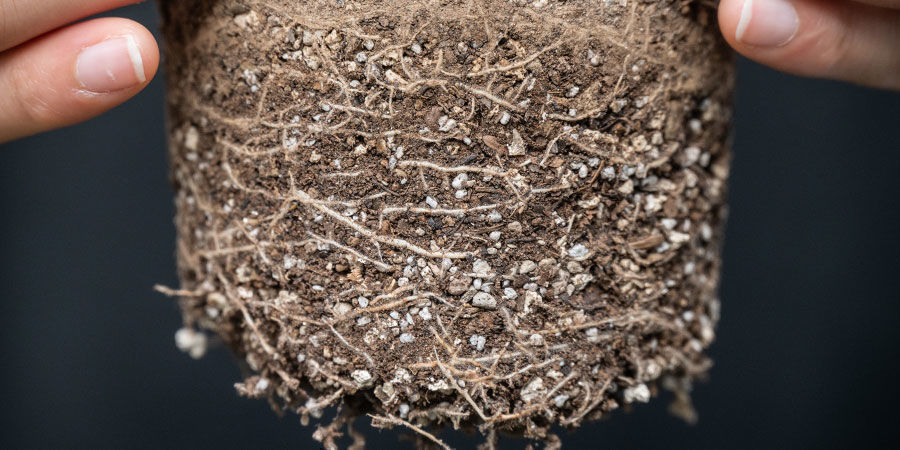
Plants become root-bound when their root system runs out of space. This typically occurs in containers that are too small in proportion to the plant. However, roots can also become bound in larger containers, or when growing in the ground and exposed to exceptionally compact soil.
Cannabis roots become more extensive as the above-ground portion of the plant becomes larger. In order to provide the plant with everything it needs to develop and survive, the roots push out into the soil in several directions; the large taproot sinks directly downwards to keep the plant anchored, whereas finer fibrous roots spread out laterally in search of nutrients and water.
When confined to a small container, cannabis roots don’t simply accept that they’re imprisoned and stop growing. Instead, they’ll expand into the limited space available, looping around the edges of the pot and tangling between each other until they form an extremely dense root ball. In an act of desperation, the roots will even poke out of the drainage holes in containers in search of space, air, nutrients, and water.
Is a root-bound cannabis plant bad?
Bound roots can cause a host of issues for cannabis plants. Severe cases affect the way roots function; considering that the roots supply water, nutrients, oxygen, and beneficial bacterial cells to plants, a reduction in efficiency is nothing but bad news for the organism as a whole. As roots struggle to procure vital supplies, growers will notice signs of deficiency and stunted growth in the above-ground parts of their plant.
How to identify root-bound cannabis plants
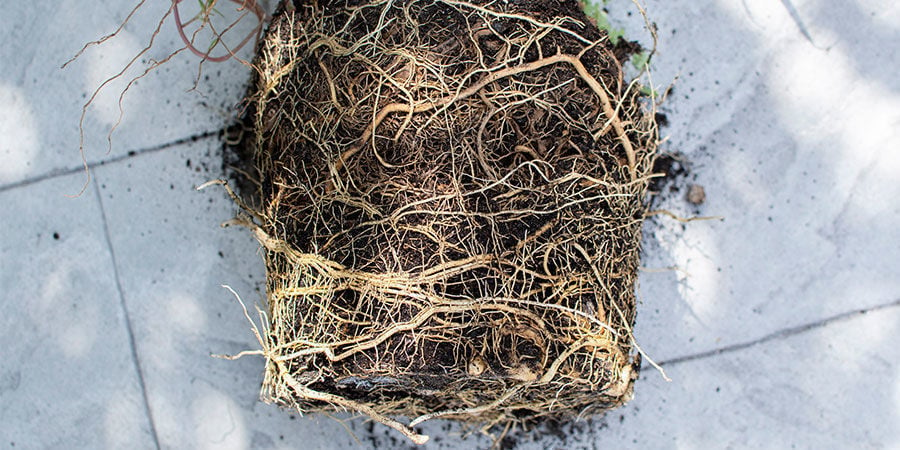
Without forcefully pulling your plants out of their containers, there are several key signs to look out for to diagnose root-bound plants. Check out the main symptoms below.
Soil is drying out too quickly
Roots facilitate the movement of water into plants through the process of transpiration. The release of water vapor through plant leaves creates a tugging force that draws water up from below. However, the soil:root ratio of a container filled with bound roots leans far towards the root side of things. This means plants will exhaust the supplies of water within a container very quickly; you could find yourself watering 2–3 times in a single day to keep up with the demand.
Plants tipping over
Under ideal conditions, the root system grows in accordance with the aerial parts of a plant. As the taproot surges downwards and the fibrous roots outward, the root system develops into a net-like structure that keeps the ever-growing canopy firmly anchored into the ground. Root-bound plants don’t receive this kind of subterranean support. You’ll often find them lying toppled over when you go to inspect them.
Slow growth
Some plants never reach the size needed for gravity to topple them. Instead, sensing that their roots are confined and unable to provide support and supplies, they remain stunted and sorry-looking, unable to provide the desired yield.
Small buds
Small plants mean small canopies and, most often, small buds. You won’t receive towering, sticky colas from root-bound plants. Rather, expect small and unimpressive inflorescences that add few figures to the scale.
Nutrient deficiencies
A mass of bound roots in a small pot can quickly take up all of the available ionic nutrients in the small quantity of growing medium. This can leave plants hungry for certain nutrients—enough to give rise to the signs of nutrient deficiencies, such as yellowing leaves, curling leaves, and brown spots.
How to fix root-bound cannabis
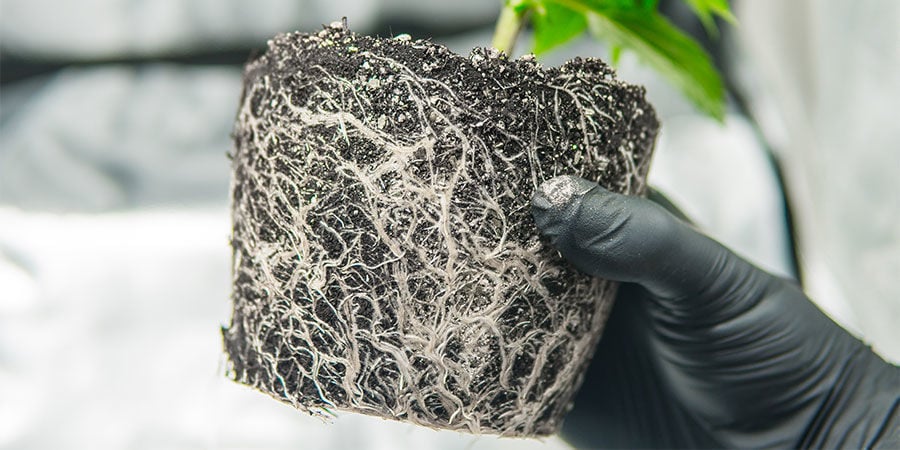
Bound roots are never a good thing, and can greatly reduce plant health and productivity. So, what steps should you take if you run into this issue? Use the following tips to help your plant recover.
- Transplant: First things first, you need to provide your plant with a spacious new home to give those roots room to grow and breathe. The size of the subsequent container will depend on the current size of your plant and the morphological features of the strain in question. A small autoflowering cultivar will do just fine in an 11l pot for the rest of the growing cycle. A plant with the capacity to reach a height of 150cm will require a pot as big as 50l; those that can peak at 200cm will need a new 75l home to reach their full potential.
- Prune the roots: During the transplanting process, prune away any roots that are growing haphazardly. Those around the edge of the root ball will have taken on the shape of the previous container and will appear squiggly and chaotic. Use a sterilised pair of pruning shears to cut away tightly packed and warped roots, leaving straighter and less-tangled roots intact.
- Loosen the root ball: Before transplanting, loosen up the root ball. Untangle any large roots the best you can without damaging them. Apply light pressure to the root ball by gently squeezing it to crumble up and dislodge any compact soil between the roots.
- New growing medium: Fill your new pot with a growing medium rich in organic matter, with a few cups of perlite, to encourage drainage while retaining moisture in soil aggregates. Sprinkle in some mycorrhizal fungi and water your plant generously.
How to prevent root-bound cannabis
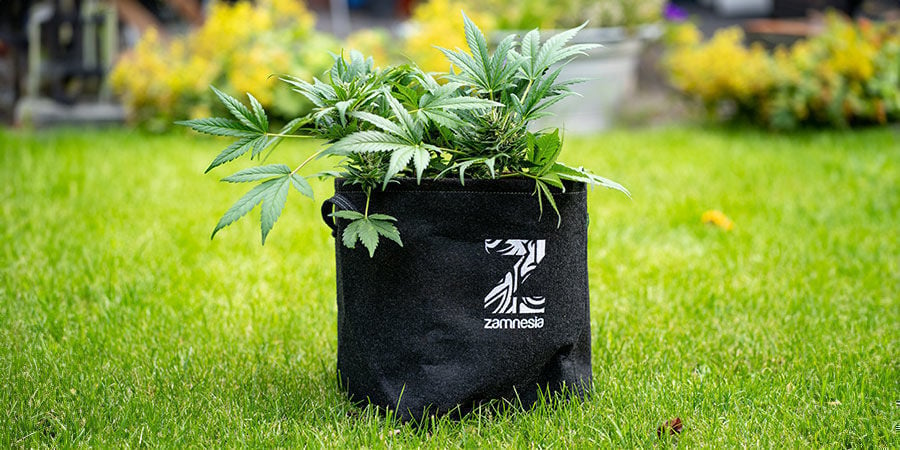
You’re now aware of how to treat a root-bound plant. Next up, find out how to prevent this issue from happening again.
Transplant timing & container selection
Transplanting your weed plants at the right time, and into the right size container, will go a long way to prevent them from becoming root-bound. To do this correctly, consider the suggested container volume for plants of different sizes below:
- 0–15cm plant = 10cm pot
- 15–30cm plant = 4l pot
- 30–60cm plant = 11l pot
- 60–100cm plant = 20l pot
- 100–150cm plant = 45l pot
- 150–200cm plant = 75l pot
Water appropriately
Keeping your soil well-hydrated will help to encourage roots to grow through it. Soil high in clay becomes extremely dense when dry, which can limit root growth even when plants are growing in a suitably sized container.
Focus on your growing medium
Starting out with an aerated and well-draining growing medium will further spur root development. Amend your potting mix with plenty of organic matter, including compost and worm castings, alongside a good amount of sand, perlite, or vermiculite.
Use fabric pots
Fabric pots essentially do away with the issue of root-bound plants entirely. In these containers, the roots of plants are naturally air-pruned, which means they won't circle around and become bound. Not only do fabric pots hep to prevent the roots from getting tangled, but they also promote proper drainage and aeration of the medium.
Keep your roots happy, healthy, and free
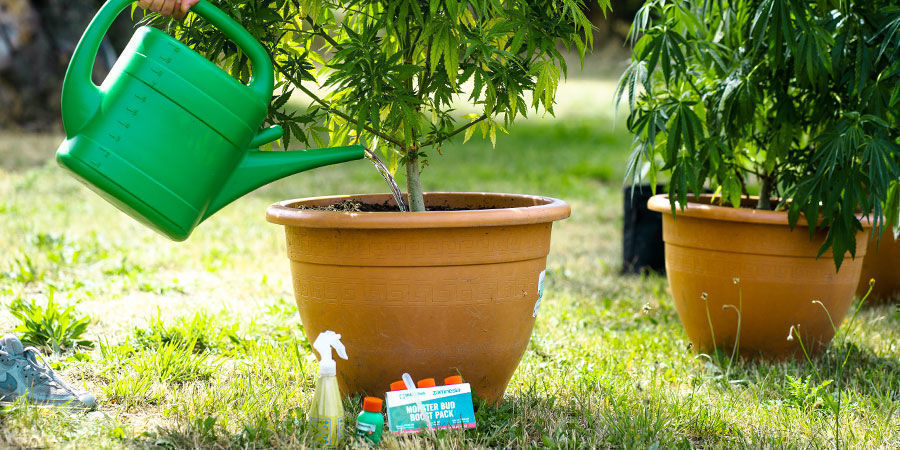
The health of every cannabis plant hinges heavily on the state of its roots. Harness the information above to save your root-bound plants, and to prevent annoyance from happening again. By transplanting at the appropriate time and growing in a big-enough container, the root system will flourish, provided it is surrounded by a rich and well-draining growing medium.













 United States
United States










